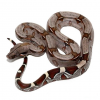Suriname Red tail Boa #2
WE HAVE SURINAME RED TAIL BOA #2 FOR SALE. HERE ARE SOME HIGHLIGHTS:
- Boa constrictor constrictor
- Field Collected
- Approximately 43 Inches In Length
- Also Known As True Redtail Boas Due To The Extreme Color On Their Tail
- These Have Crisp Colors That They Retain Even Into Adulthood
- Feeding On Live Or Frozen Thawed Rat Pups Weekly
- Naturally Occurring In South America, But Primarily Out Of Suriname
- Adults Can Reach Up To 6-8 Feet In Length
- With Proper Care And Set Up Care These Boas Are Able To Live Up To 20-25+ Years
- Boas Can Give Birth To 30 – 50 Live Babies At A Time
- These Are Tropical And Semi Arboreal So Be Sure To Provide Branches For Climbing And Temperatures In The 80’s
True Suriname Red tail Boa #2 are often sought after because of their beautifully colored red tails, unique dorsal saddles and often pink or purple coloration along the sides of their bodies. Boa c. constrictor are the nominate species of the complex, meaning they were the first of the species type to be described by LINNAEUS in 1758.
Buy Suriname Red tail Boa #2
Suriname red-tailed boas vary greatly in appearance depending on their locality. Although hobbyists often will seek out specific traits in locality types such as Suriname’s with large “widow” peaks, or Guyanese boas with pick sides, the reality is that each locality is highly variable in color and pattern. Husbandry compared to the smaller Boa imperator, although true red tail boas tend to be less tolerant of frequent handling. They also require higher humidity and warmer summer temperatures than the smaller Boa c. imperator.
Furthermore, breeding Boa c. constrictor is also a greater challenge than other Boa c. spp., requiring cooler nigh time lows (66-68 F), dryer days, and often longer cooling periods to coax them into breeding.
Unfortunately, there are still many thousands of wild caught or farmed boas imported each year. As a result, imported animals tend to fare poorly in comparison to captive bred individuals, stressing more easily and plagued with both internal and external parasites. However, with captive breeding so common, as a result its very easy to find well established captive bred offspring.




Reviews
There are no reviews yet.